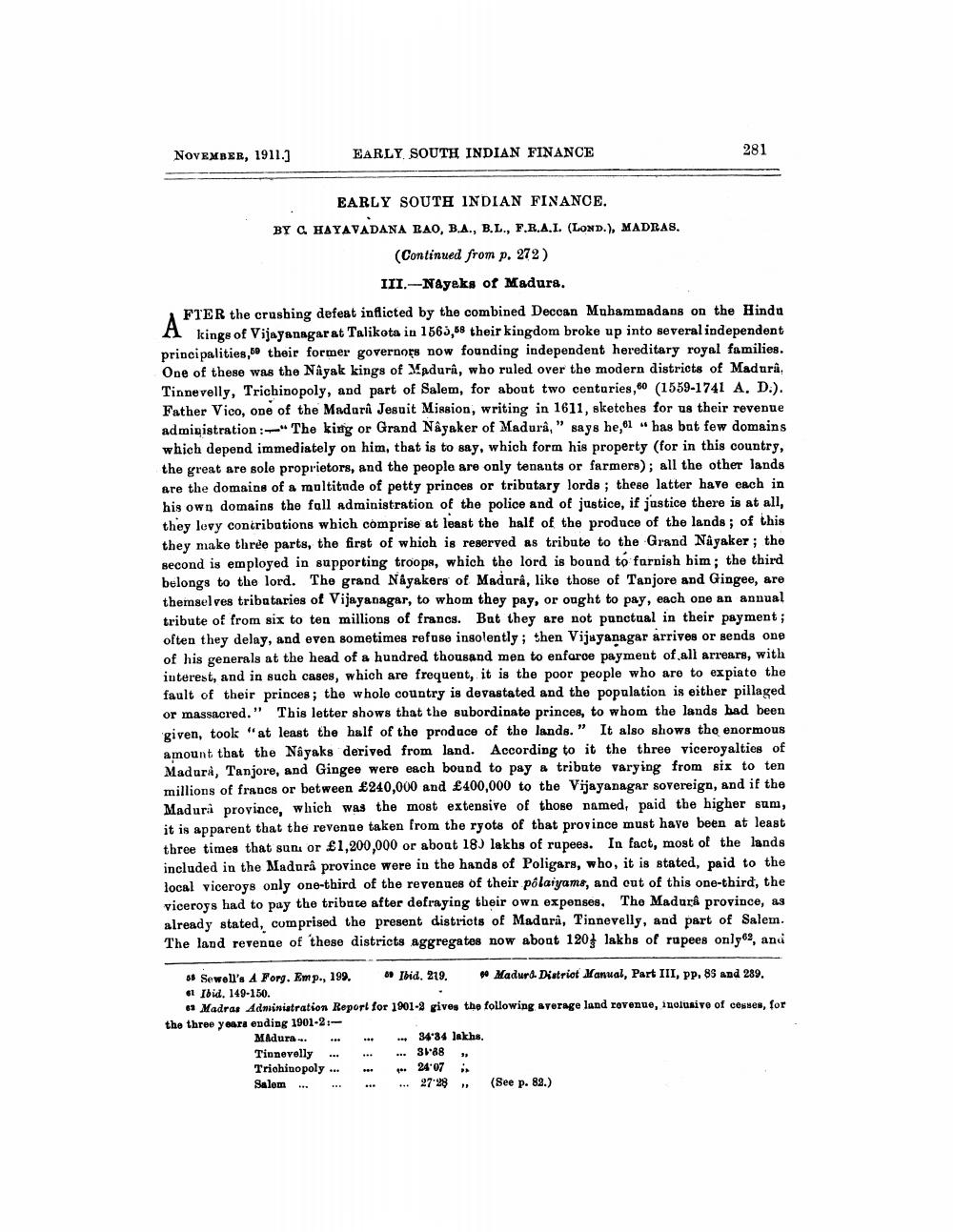________________
NOVEMBER, 1911.)
EARLY SOUTH INDIAN FINANCE
281
EARLY SOUTH INDIAN FINANCE. BY G HAYAVADANA RAO, B.A., B.L., F.R.A.I. (LOND.), MADRAS.
(Continued from p. 272)
III.-Nayeks of Madura. FTER the crushing defeat inflicted by the combined Deccan Muhammadans on the Hindu A kings of Vijayanagarat Talikota in 1565,58 their kingdom broke up into several independent principalities, their former governors now founding independent hereditary royal families. One of these was the Nayak kings of Madura, who ruled over the modern districts of Madura, Tinnevelly, Trichinopoly, and part of Salem, for about two centuries, 60 (1559-1741 A, D.). Father Vico, one of the Madari Jesuit Mission, writing in 1611, sketches for us their revenue administration: The king or Grand Nayaker of Madura," says he,61 " has bat few domains which depend immediately on him, that is to say, which form his property (for in this country, the great are sole proprietors, and the people are only tenants or farmers); all the other lands are the domains of a multitude of petty princes or tributary lords; these latter have each in his own domains the fall administration of the police and of justice, if justice there is at all, they levy contributions which comprise at least the half of the produce of the lands; of this they make three parts, the first of which is reserved as tribute to the Grand Nayaker; the second is employed in supporting troops, which the lord is bound to furnish bim; the third belongs to the lord. The grand Nayakers of Madura, like those of Tanjore and Gingee, are themselves tribataries of Vijayanagar, to whom they pay, or ought to pay, each one an annual tribute of from six to ten millions of francs. But they are not punctual in their payment; often they delay, and even sometimes refuse insolently; then Vijayanagar arrives or sends one of his generals at the head of a hundred thousand men to enfaroe payment of all arrears, with interest, and in such cases, which are frequent, it is the poor people who are to expiate the fault of their princes; the whole country is devastated and the population is either pillaged or massacred." This letter shows that the subordinate princes, to whom the lands had been given, took "at least the half of the produce of the lands." It also shows the enormous amount that the Nayaks derived from land. According to it the three viceroyalties of Madura, Tanjore, and Gingee were each bound to pay a tribute varying from six to ten millions of francs or between £240,000 and £400,000 to the Vijayanagar sovereign, and if the Maduri province, which was the most extensive of those named, paid the higher sum, it is apparent that the revenue taken from the ryots of that province must have been at least three times that sunı or £1,200,000 or about 18) lakhs of rupees. In fact, most of the lands included in the Madura province were in the hands of Poligars, who, it is stated, paid to the local viceroys only one-third of the revenues of their polaiyams, and cut of this one-third, the viceroys had to pay the tribate after defraying their own expenses. The Madurâ province, as already stated, comprised the present districts of Madarà, Tinnevelly, and part of Salem. The land revenue of these districts aggregates now about 120 lakhs of rapees only, and
* Sewell's A Forg. Emp., 199. Ibid. 219. Madurd. District Manual, Part III, PP. 85 and 289. el Ibid. 149-150.
# Madras Administration Report for 1901-2 gives the following average land rovenue, inclusive of cesses, for the three years ending 1901-2:
MAdura... .. .. 3434 lakhs. Tionevolly ... ... . 3V-88 » Trichinopoly ...
24.07 Salom ... ..
... 27 28 . (See p. 82.)




